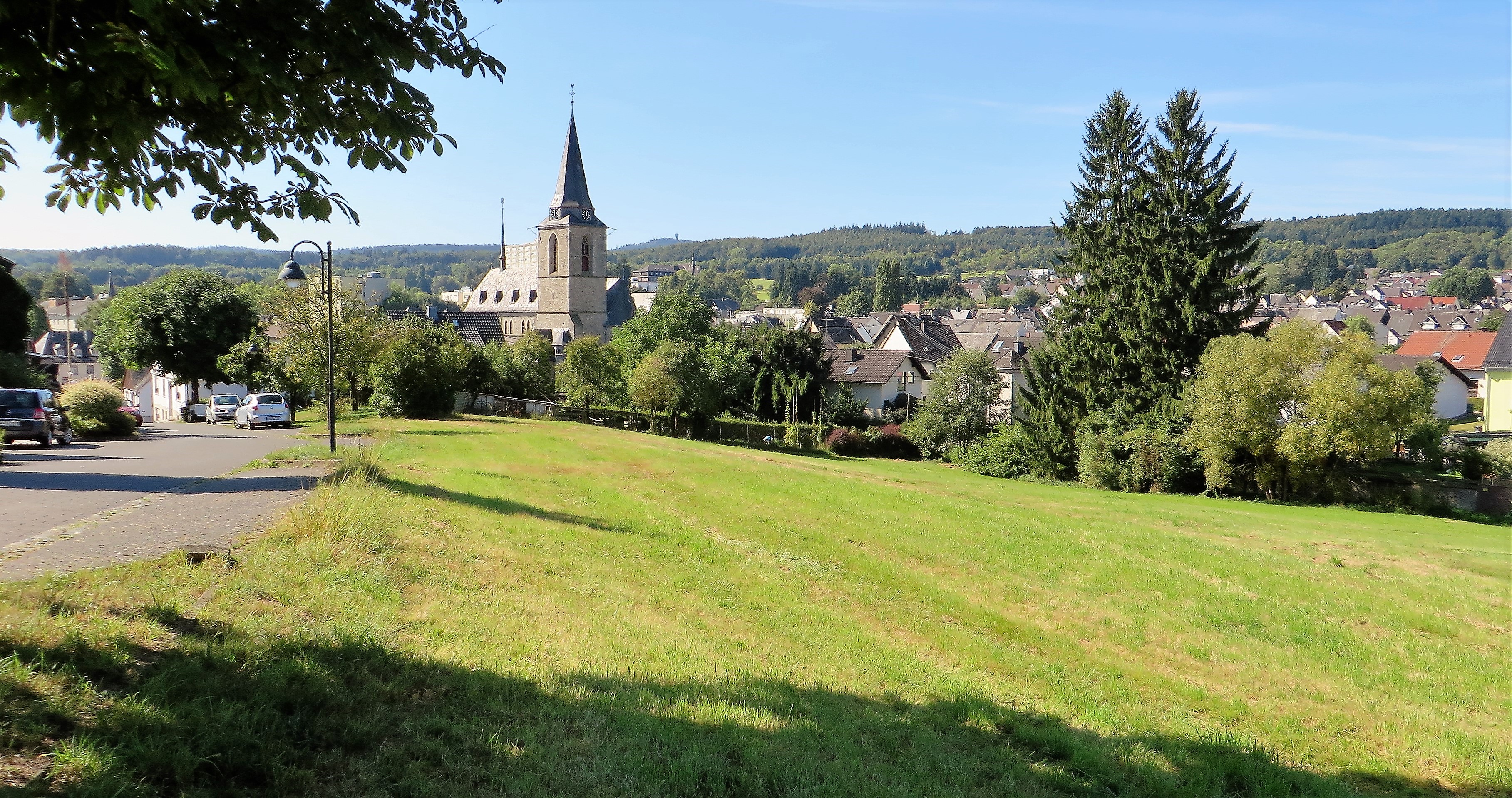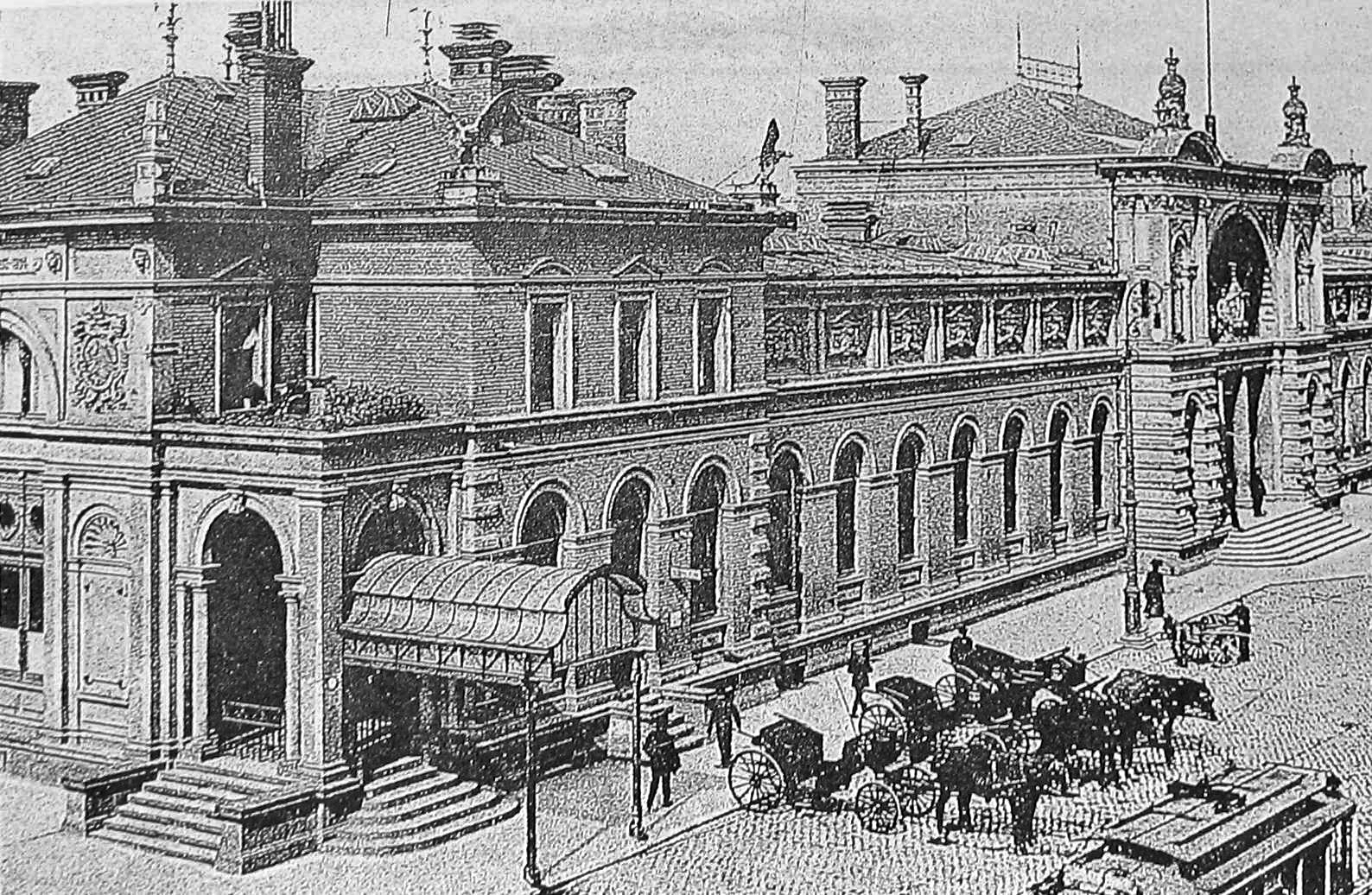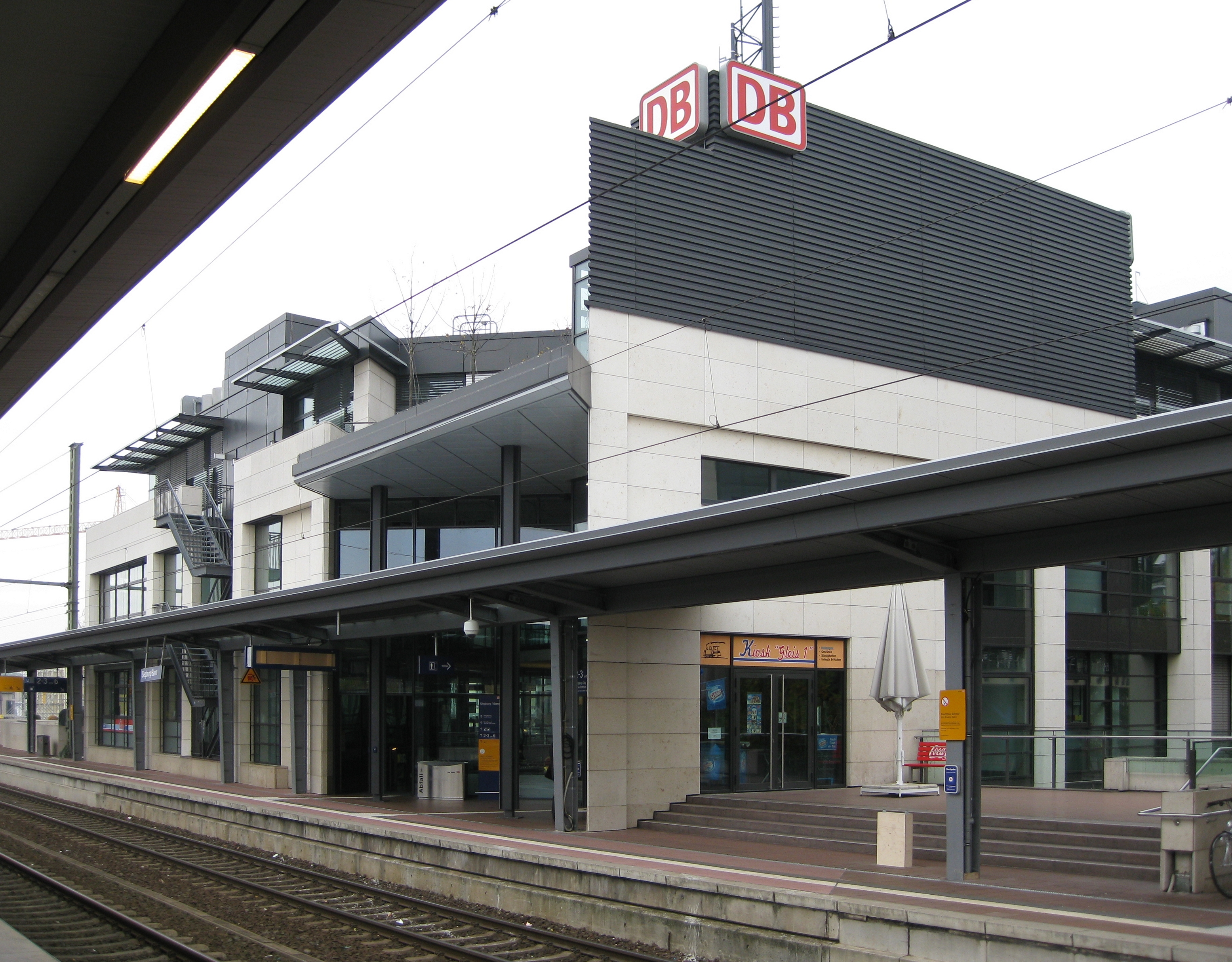|
Montabaur Station
Montabaur station is a station at the 89.1 kilometre point of the Cologne-Frankfurt high-speed railway and on the Limburg–Siershahn railway (Lower Westerwald Railway) in the German state of Rhineland-Palatinate. The station, which is served by regional and long-distance passenger services and freight traffic, is on the outskirts of the town of Montabaur. It is aligned parallel with Autobahn 3 (A3), which runs immediately to the north. The construction costs amounted to €23.6 million. Station infrastructure The new line runs through the area of the station on a roughly 15 metre-high embankment. The station's tracks are divided into an area for high-speed line operations (with the German operating points code of FMT) and an area serving regional operations on the Lower Westerwald Railway (operating points abbreviation FMTN). There is only an indirect connection between the two parts: the eastern catch point from the northern Intercity-Express (ICE) platform track (4), has a ... [...More Info...] [...Related Items...] OR: [Wikipedia] [Google] [Baidu] |
Montabaur
Montabaur () is a town and the district seat of the Westerwaldkreis in Rhineland-Palatinate, Germany. At the same time, it is also the administrative centre of the ''Verbandsgemeinde'' of Montabaur – a kind of collective municipality – to which 24 other communities belong. The town is known throughout the country for its strikingly yellow castle and its InterCityExpress railway station on the Cologne-Frankfurt high-speed rail line. Geography Location Montabaur lies in the Westerwald, roughly 20 km northeast of Koblenz. About 14,000 people live in the city, while the district is home to about 40,000. Constituent communities Montabaur has seven outlying centres. In the north lies Eschelbach, and in the west lie Horressen and Elgendorf. Stretching south along the Gelbach valley are the pilgrimage centre of Wirzenborn, and, farther along still, Reckenthal, Bladernheim and Ettersdorf. Neighbouring communities Montabaur's neighbours are, clockwise beginning in th ... [...More Info...] [...Related Items...] OR: [Wikipedia] [Google] [Baidu] |
Nuremberg–Munich High-speed Railway
The Nuremberg–Munich high-speed railway line is a high-speed railway running between the two largest cities in Bavaria, Germany: Nuremberg and Munich. The northern section, between Nuremberg and Ingolstadt, is a track built between 1998 and 2006. It is in length with nine tunnels (total length: ). In order to minimize damage to the environment, it runs for the most part right next to Bundesautobahn 9. The southern section, between Ingolstadt and Munich, is 19th-century track. Its southern section has been upgraded for up to . Between 2010 and 2013, further upgrades to the midsection of the track will be done. The minimum speed on the Munich-Ingolstadt section should then be , with in the middle and 200 km/h in the southern section. Both long-distance and regional services operate on the line. Intercity-Express trains reach the tracks' 300 km/h speed-limit. InterCity and RegionalExpress trains travel at a maximum speed of 200 km/h. The Allersberg-Express, a R ... [...More Info...] [...Related Items...] OR: [Wikipedia] [Google] [Baidu] |
Dernbach, Westerwaldkreis
Dernbach (Westerwald) is a local community (Ortsgemeinde) in the district of Westerwaldkreis in Rhineland-Palatinate, Germany, and part of the municipal association Verbandsgemeinde Wirges. The village is known throughout the country by the three-way interchange A48/A3, called ''Dernbacher Dreieck'', and well known worldwide by the international congregation Poor Handmaids of Jesus Christ, called ''Dernbacher Schwestern''. Etymology Unlike many other surrounding villages, Dernbach has not a Franconian, but a Celtic toponym. Several communities and families have the same name, so it has become customary to say "Dernbach bei Montabaur", to avoid confusion. Geography Location Dernbach is located north of the city of Montabaur within the wooded hills of the national nature reserve "Naturpark Nassau". Surrounding villages are Ebernhahn, Wirges, Staudt, Eschelbach and Elgendorf. Geology Due to its subterranean natural resources, such as iron ore, silver and lead deposits, Dernbach ... [...More Info...] [...Related Items...] OR: [Wikipedia] [Google] [Baidu] |
Carl-Ludwig Wagner
Carl-Ludwig Wagner (9 January 1930 – 27 July 2012) was a German politician of the Christian Democratic Union. Wagner was born in Düsseldorf, but later lived in Eitelsbach, a part of Trier. After his Abitur 1949 in Trier he studied law at the University of Mainz and one year in Montpellier. He got his doctorate in 1961. Wagner was the 5th Minister President of Rhineland-Palatinate from 1988 to 1991, Minister from 1979 to 1988 (law, finances), a member of the Bundestag (1969–1976) and worked for the European Parliament in Luxembourg Luxembourg ( ; lb, Lëtzebuerg ; french: link=no, Luxembourg; german: link=no, Luxemburg), officially the Grand Duchy of Luxembourg, ; french: link=no, Grand-Duché de Luxembourg ; german: link=no, Großherzogtum Luxemburg is a small lan ... from 1959 to 1969. References External links * {{DEFAULTSORT:Wagner, Carl-Ludwig 1930 births 2012 deaths Johannes Gutenberg University Mainz alumni University of Montpellier alu ... [...More Info...] [...Related Items...] OR: [Wikipedia] [Google] [Baidu] |
Bonn Central Station
Bonn Hauptbahnhof is a railway station located on the left bank of the Rhine along the Cologne–Mainz line. It is the principal station serving the city of Bonn. In addition to extensive rail service from Deutsche Bahn it acts as a hub for local bus, tram, and Stadtbahn services. History The first station was constructed in 1844 by the Bonn-Cologne Railway Company, as part of the West Rhine Railway. The current building was erected between 1883 and 1884. From 1870 a train ferry connected Bonn station to the East Rhine Railway. With the opening of the Voreifel Railway to Euskirchen, the station became a rail junction. In 1883 and 1884, a new station building was erected, which is now heritage listed. The station sharply increased in importance in 1949, when Bonn became capital of the Federal Republic. Many politicians and federal employees travelled by train, as did guests of the state. In 1969, Bonn grew considerably by incorporating towns which includes the stations ... [...More Info...] [...Related Items...] OR: [Wikipedia] [Google] [Baidu] |
Siegburg/Bonn Station
Siegburg/Bonn station, in the town of Siegburg, North Rhine-Westphalia, Germany, is on the Cologne–Frankfurt high-speed rail line and the Sieg Railway. It was rebuilt for the high-speed line and is connected to Bonn by the Siegburg line of the Bonn Stadtbahn. It is in the network area of the Verkehrsverbund Rhein-Sieg (Rhine-Sieg Transport Association). History The original Siegburg station opened in 1859 on the Sieg Railway (german: Siegstrecke). In 1870, Siegburg became the northern end of the East Rhine Railway (''Rechte Rheinstrecke''), with the intention that it would be later extended through the Agger valley through the Ruhr to Bochum or Essen, so that Siegburg would become a significant railway junction. Influential people in Cologne finally prevailed, so instead the East Rhine Railway was extended from Friedrich-Wilhelms-Hütte to Troisdorf in order to connect to Cologne, resulting in the line to Siegburg becoming only a branch line parallel with the Sieg Railway. ... [...More Info...] [...Related Items...] OR: [Wikipedia] [Google] [Baidu] |
Deutschmark
The Deutsche Mark (; English: ''German mark''), abbreviated "DM" or "D-Mark" (), was the official currency of West Germany from 1948 until 1990 and later the unified Germany from 1990 until the adoption of the euro in 2002. In English, it was typically called the "Deutschmark" (). One Deutsche Mark was divided into 100 pfennigs. It was first issued under Allied occupation in 1948 to replace the Reichsmark and served as the Federal Republic of Germany's official currency from its founding the following year. On 31 December 1998, the Council of the European Union fixed the irrevocable exchange rate, effective 1 January 1999, for German mark to euros as DM 1.95583 = €1. In 1999, the Deutsche Mark was replaced by the euro; its coins and banknotes remained in circulation, defined in terms of euros, until the introduction of euro notes and coins on 1 January 2002. The Deutsche Mark ceased to be legal tender immediately upon the introduction of the euro—in contrast to the o ... [...More Info...] [...Related Items...] OR: [Wikipedia] [Google] [Baidu] |
Bonn
The federal city of Bonn ( lat, Bonna) is a city on the banks of the Rhine in the German state of North Rhine-Westphalia, with a population of over 300,000. About south-southeast of Cologne, Bonn is in the southernmost part of the Rhine-Ruhr region, Germany's largest metropolitan area, with over 11 million inhabitants. It is a university city and the birthplace of Ludwig van Beethoven. Founded in the 1st century BC as a Roman settlement in the province Germania Inferior, Bonn is one of Germany's oldest cities. It was the capital city of the Electorate of Cologne from 1597 to 1794, and residence of the Archbishops and Prince-electors of Cologne. From 1949 to 1990, Bonn was the capital of West Germany, and Germany's present constitution, the Basic Law, was declared in the city in 1949. The era when Bonn served as the capital of West Germany is referred to by historians as the Bonn Republic. From 1990 to 1999, Bonn served as the seat of government – but no longer capital – ... [...More Info...] [...Related Items...] OR: [Wikipedia] [Google] [Baidu] |
Helmut Kohl
Helmut Josef Michael Kohl (; 3 April 1930 – 16 June 2017) was a German politician who served as Chancellor of Germany from 1982 to 1998 and Leader of the Christian Democratic Union (CDU) from 1973 to 1998. Kohl's 16-year tenure is the longest of any German chancellor since Otto von Bismarck, and oversaw the end of the Cold War, the German reunification and the creation of the European Union (EU). Further, Kohl's 16 years and 30 day tenure is the longest for any democratically elected Chancellor of Germany. Born in 1930 in Ludwigshafen to a Catholic family, Kohl joined the CDU in 1946 at the age of 16. He earned a PhD in history at Heidelberg University in 1958, and worked as a business executive before becoming a full-time politician. He was elected as the youngest member of the Landtag of Rhineland-Palatinate, Parliament of Rhineland-Palatinate in 1959 and from 1969 to 1976 was Minister-president, minister president of the Rhineland-Palatinate state. Viewed during the 1960s ... [...More Info...] [...Related Items...] OR: [Wikipedia] [Google] [Baidu] |
Der Spiegel
''Der Spiegel'' (, lit. ''"The Mirror"'') is a German weekly news magazine published in Hamburg. With a weekly circulation of 695,100 copies, it was the largest such publication in Europe in 2011. It was founded in 1947 by John Seymour Chaloner, a British army officer, and Rudolf Augstein, a former Wehrmacht radio operator who was recognized in 2000 by the International Press Institute as one of the fifty World Press Freedom Heroes. Typically, the magazine has a content to advertising ratio of 2:1. ''Der Spiegel'' is known in German-speaking countries mostly for its investigative journalism. It has played a key role in uncovering many political scandals such as the ''Spiegel'' affair in 1962 and the Flick affair in the 1980s. According to ''The Economist'', ''Der Spiegel'' is one of continental Europe's most influential magazines. The news website by the same name was launched in 1994 under the name ''Spiegel Online'' with an independent editorial staff. Today, the content is ... [...More Info...] [...Related Items...] OR: [Wikipedia] [Google] [Baidu] |
Railroad Switch
A railroad switch (), turnout, or ''set ofpoints () is a mechanical installation enabling railway trains to be guided from one track to another, such as at a railway junction or where a spur or siding branches off. The most common type of switch consists of a pair of linked tapering rails, known as ''points'' (''switch rails'' or ''point blades''), lying between the diverging outer rails (the ''stock rails''). These points can be moved laterally into one of two positions to direct a train coming from the point blades toward the straight path or the diverging path. A train moving from the narrow end toward the point blades (i.e. it will be directed to one of the two paths, depending on the position of the points) is said to be executing a ''facing-point movement''. For many types of switch, a train coming from either of the converging directions will pass through the switch regardless of the position of the points, as the vehicle's wheels will force the points to move. ... [...More Info...] [...Related Items...] OR: [Wikipedia] [Google] [Baidu] |
Rhine
), Surselva, Graubünden, Switzerland , source1_coordinates= , source1_elevation = , source2 = Rein Posteriur/Hinterrhein , source2_location = Paradies Glacier, Graubünden, Switzerland , source2_coordinates= , source2_elevation = , source_confluence = Reichenau , source_confluence_location = Tamins, Graubünden, Switzerland , source_confluence_coordinates= , source_confluence_elevation = , mouth = North Sea , mouth_location = Netherlands , mouth_coordinates = , mouth_elevation = , progression = , river_system = , basin_size = , tributaries_left = , tributaries_right = , custom_label = , custom_data = , extra = The Rhine ; french: Rhin ; nl, Rijn ; wa, Rén ; li, Rien; rm, label= Sursilvan, Rein, rm, label= Sutsilvan and Surmiran, Ragn, rm, label=Rumantsch Grischun, Vallader and Puter, Rain; it, Reno ; gsw, Rhi(n), inclu ... [...More Info...] [...Related Items...] OR: [Wikipedia] [Google] [Baidu] |








